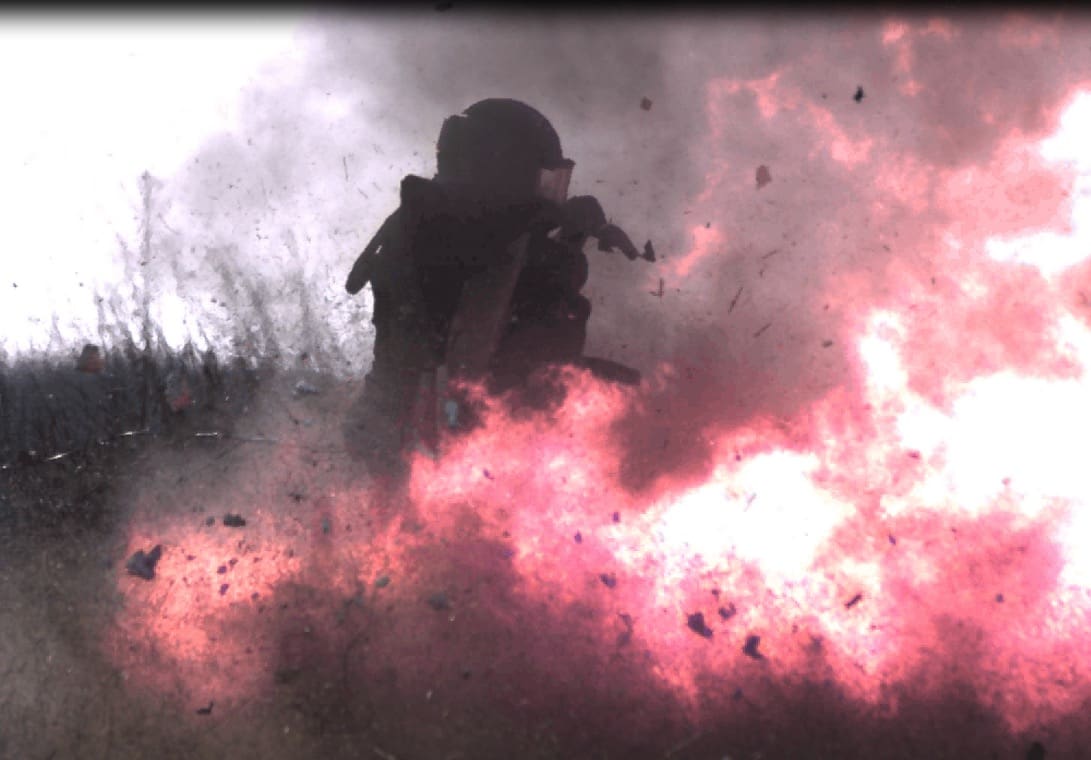A new video released by Morgan Advanced Materials showcases the outstanding performance of its Silverback 4020 Elite bomb disposal suit against four life impacting aspects of blast; flame immersion, high velocity fragment impact, blast pressure wave and ‘tertiary’ effects; across four different blast tests.
Critical to survivability, the tests illustrate the importance Morgan places on reducing the impact of blast pressure waves, which alongside flame and fragments, have devastating impact on internal organs without adequate protection. The testing was conducted at the independently certified OTS testing facility at Faldingworth (UK) and utilised a range of testing best practice, including key aspects of the NIJ 0117.00 Public Safety Bomb Suit Standard, in addition to other blast analysis including the Bowen Survivability Curve and overpressure reduction.
The first blast test shown on the video demonstrates the suit’s survivability when kneeling, measured against the NIJ 0117.00 Public Safety Bomb Suit Standard for an explosive of 0.567kg C4 threat at 0.6m. The recorded footage reveals that the suit provides a pressure reduction between 96.9% and 99.7%, achieving a position on the Bowen Curve showing more than 99% survivability probability (in a controlled test environment). Three further blast tests assess the suit’s survivability when standing, facing a 1kg (2.20 lbs) C4 threat at 1m, a 2kg (4.41 lbs) C4 threat at 2m, and a 10kg (22.05 lbs) C4 threat at 3m. All three tests returned a position on the Bowen Curve stating a survivability probability greater than 99% (in a controlled test environment), with a pressure reduction between 98.1% and 98.5% for 1kg and 10kg blasts.
In addition to ensuring the highest levels of survivability, the Silverback 4020 Elite is designed for enhanced manoeuvrability, providing the Explosive Ordnance Disposal (EOD) operator with the flexibility they require for operating in a restrictive environment. The business conducts its own manoeuvrability tests, testing flexibility to crouch, climb and crawl, furthermore the suit utilises a powerful demisting system embedded in the helmet for improved situational awareness. Advanced cooling systems, which incorporate a flame ingress brake mechanism are embedded into the suit enhance comfort and reduce operator fatigue. An innovative quick release system, allowing the user to evacuate the suit unaided in less than 25 seconds in the event of an emergency situation, is designed into the suit’s jacket and trousers.
Chris Davies, Technology Director at Morgan Advanced Materials’ Composites and Defence Business, commented: “We are delighted with the survivability performance of the Silverback 4020 Elite, reducing the impact of blast pressure waves has been a key focus throughout the design of the product, along with protection against flame and fragments. The suit’s high performance levels have been achieved through years of blast materials research and development, combined with leading garment engineering to create a truly world class highly flexible bomb disposal suit.“
For further information, please visit: www.morgandefencesystems.com/blast-test



Is this the standard suit of choice for the U.K.? I’ve never worn anything that wasn’t med-eng, or even gotten a reasonable up close look. Can’t argue that the numbers don’t make it look good!
That’s what I was just thinking. I’ve always worn the EOD 6 or EOD 9 (? been a bit) from Med-eng. I know some who were in procurement that were discussing new suits but hadn’t heard of another manufacture besides MED-ENG.
Least this one doesn’t have the snorkel.
Were the charges just sat out in the open? Hard to tell from the video. Seems unlikely you’d encounter a charge not contained with a pressure vessel of some description. Need an objective way to test though no doubt.
Either way, it’s about making the squishy stuff inside the hard stuff survive and still be able to do the work and if this does better than the current offerings that’s absolutely fantastic. Worked with many guys who’ve spent time in EOD, big props to anyone putting so much effort in to gear like this which no doubt involves some astronomical costs in terms of R&D.
REMF Tacticool- They do a bunch of tests on the suits with bare and fragmentation charges (hand grenades) at different distances. I can’t remember where the video is at but the tests are designed to show both frag and blast effects (thus bare charges). I think there are tests out there on youtube that show the capabilities of the MED-ENG suits.
you’re right too- make the squishy hard enough to be thrown instead of shredded.
The test set up seems flaky since everything gets destroyed after each test; this is not normal and raises questions about the repeatability of any tests using random pieces of wood to support mannequins and sensors that go flying every time!
OTS is NOT certified to test according to NIJ standard. References to NIJ standard are erroneous since the protocols are not being followed. NIJ requires testing at a certified laboratory.
Having tested for many years, these claims of blast overpressure reductions seem suspect and are probably a result of some “cherry picking” of results or isolated tests (not repeated).
Looks like they are referring to the blast sizes and distances – no claim of NIJ certification, only being tested compliant to the spec. These are the suits used by the UK MoD I understand – I am sure the UK has much more stringent blast and fragment testing considering the UK has been buying various generations of these suits for over 30 years. I fully believe the results and doubt they are limited cases.